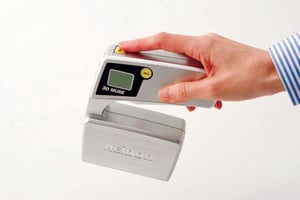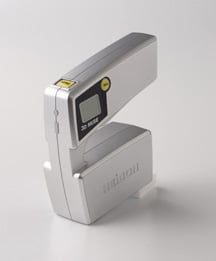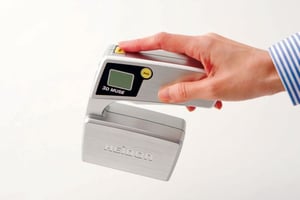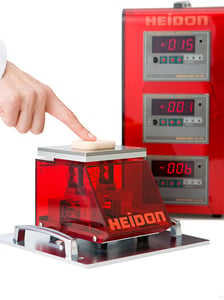 In many parts of the country, wintertime means icy temperatures, sleet, freezing rain and snow. And all of this weather can mean big trouble when it comes to friction.
In many parts of the country, wintertime means icy temperatures, sleet, freezing rain and snow. And all of this weather can mean big trouble when it comes to friction.
Any moisture or ice can affect traction, making our commute to work a little more dangerous and some floors and walkways slippery and scary.
Now that the temperatures have dropped, it’s time to invest in a portable tribometer. Why? Because roads are so slippery that slush gets tracked inside on our shoes, and cold temperatures affect basic machinery and its ability to function normally.
So how can a portable tribometer help you in the wintertime? Let’s examine a few ways a portable tribometer can be used for winter safety—and even a little outdoor winter fun.
Lower Temperatures and the Effect They Have on Friction
Winter can have a major effect on the vehicles we use every day once the temperature plummets.
For example, the viscosity of the crankcase oil in a diesel engine can change completely in subzero temperatures, affecting the cold-start abilities of an engine. This is why many diesel engines require time to warm up before they go anywhere—because the viscosity of the oil has been changed by the frigid temperatures. This is why many diesel engines have a diesel engine block heater, as well.
Without allowing the engine time to warm up, the fuel can gel in colder temperatures (especially if it is not a winter blend fuel), and the battery will not crank strongly enough to start the engine. All of this is not good for the engine as it becomes subject to wear without proper lubrication.
Tribometers are not only used to study this wear in diesel engines in cars and trucks but also in trains that operate in weather as cold at -45 degrees Celsius. Tribometers also are used to test the tribological materials and oils used in these trains in order to enhance their performance in these very low temperatures. In addition to measuring how train engines function in temperature extremes, portable friction analyzer are used for another important "train-related" task. For a locomotive to effectively move on train tracks, up and down inclines, and around curves, the track needs to have enough friction so the wheels don't slip... or at least slip too much! Using a portable friction analyzer, lubricants, coatings, and wear can be evaluated at the specific location and under the specific ambient conditions that are of most concern.
A great instrument to use to measure and track these changes in friction is the 3D Muse Portable Friction Meter, which can be used practically anywhere. It does not require special operators and works well outdoors and on sloping surfaces.
Another way cold weather affects transportation-related friction? When summer tires get too cold, the rubber reacts to the temperature and hardens, losing much of its friction. This change in rubber’s hardness is known as glass transition. When these rubber tires become rock-hard in cold weather, they lose much of their traction. This can be dangerous when the roads are already icy and slick as a result of freezing rain or snow and can affect stopping times or cause cars to slide all over the road.
Tribometers can be used to measure this change in tire rubber to develop new and safer winter tires that do not harden the same way that summer tires do, providing improved friction and a safer driving experience. The Heidon 94Ai static friction meter can measure the static friction coefficient in between your tires and the road.
Also, check out this cool mention of Kett’s products in Wisconsin’s road safety study on the study and safe use of de-icing and anti-icing chemicals. Kett’s products, much like the portable friction tester seen in this study, can help keep roads safe by preventing ice from ever forming.
The bottom line? Winter is a great time to invest in a portable tribometer that will help develop safer, more effective technology to keep our cars and engines running smoothly. The icy temperatures are the perfect time to test oil’s efficiency and even determine the safety of the tires on your own car at home.
Are your tires safe for your next winter trip to visit family? A tribometer can tell you.
Preventing Slips and Falls
Some floor surfaces are better than others when it comes to providing traction when ice and snow are brought in on the bottoms of shoes and boots. This can create very dangerous and slippery situations.
Is your floor safe in the wintertime? And is it still safe if slush is carried in after a snowstorm?
It’s vital to analyze the friction of commercial or industrial floors—especially in the winter when everything is covered in ice, snow and slush—to maintain a safe working space.
While OSHA does not have a set requirement for floor traction, it does recommend that a reasonable measure of slip resistance is a static coefficient of friction (COF) of 0.5. This value is not intended to be an industry standard but is a good guideline to follow nonetheless.
OSHA also states that “a higher COF may be necessary for certain work tasks, such as carrying objects, pushing or pulling objects, or walking up or down ramps.” This is especially true when temperatures drop and icy weather hits.
Is your floor in need of resurfacing in order to maintain a safe work environment? Only a tribometer can tell you. Floor surfaces can wear down over time and become smooth and slippery. Again, the 3D Muse Portable Friction Meter can test your floor inside and your walkways outside, even working well to monitor friction on ramps.
A “Cool” Use for Tribometers
One very “cool” application of tribometers is to test skis and ski gear like ski bases, runners for sleds and waxes. That’s right—tribometers are used to measure just how slippery skis and ski equipment are. In other words, tribometers are used to measure how little friction there is between the ski and the snow. The less friction, the faster the skier will go!
For this kind of testing, manufacturers and developers use a rotating substrate to test their products, much like our TriboCCD system option that is listed on page seven of this PDF.
Whether you want friction working to slow you down, like the traction we need in our tires to stop on an icy road, or speed you up, like on the bottom of your ski bases, Kett can be there throughout the winter to track and measure just how much friction there is, keeping you safe all season long. What kind of a portable tribometer is the right fit for your needs? Let’s find out together. Contact us today and let us help you find the perfect tool to keep your floors safe, your engines running, your skis skiing, and any other need you might have this season.



